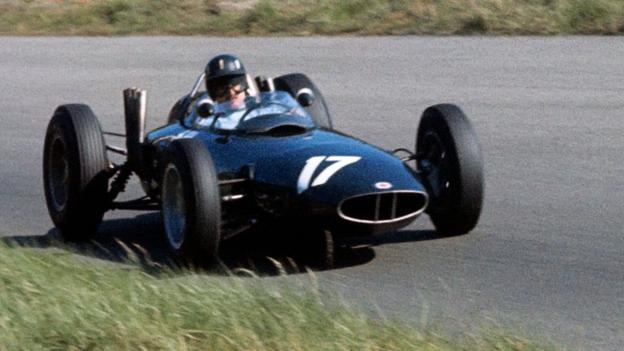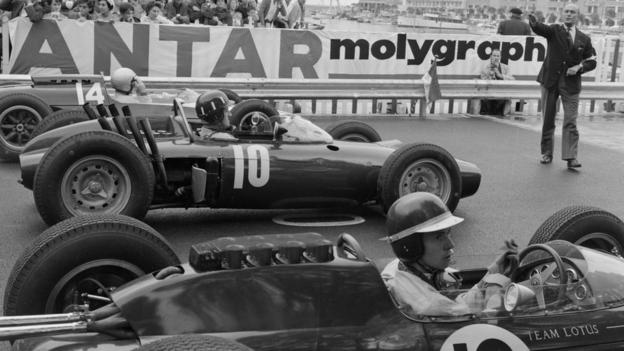
The second race of the 2021 F1 season is on Sunday with the Emilia-Romagna Grand Prix. Over the winter break, the head of F1, Stefano Domenicali, mentioned his desire for Formula 1 to return to Africa – to make it a true World Championship.
F1 has not been to Africa since 1993, but before that there were a number of exciting and dramatic races held on the continent. This is the story of the second of those – the 1962 South African Grand Prix.
The context

The current F1 season may be long – but in 1962, it did not finish until after Christmas.
The first South African Grand Prix, held at the Prince George circuit in East London, was on 29 December 1962. First practice was on Boxing Day.
However, unlike today’s packed 23-race calendar, this was only the ninth Grand Prix of the season – and it was taking place nearly three months after the previous US Grand Prix had finished with a result that set South Africa up for a fantastic title-deciding showdown.
Just like the first Formula 1 race in Africa the second one was also the climactic end to a Grand Prix with two British drivers contesting the title to see who would take it for the first time.
In 1958 in Casablanca, it had been Mike Hawthorn and Stirling Moss, Hawthorn coming out on top. In 1962 in East London, it was Graham Hill and Jim Clark.
Qualifying

Although the points system at the time was rather complex – drivers could only count their five best finishes – it added up to one simple scenario: if Clark won the race, he won the title. Anything else, it was Hill’s.
What made this setup so delicious was that Clark was usually the faster driver – but his Lotus was prone to mechanical problems.
If he made it to the finish, it was usually in first place. While Hill was not always able to keep up, his BRM was more reliable.
The pair were in a class of their own in qualifying. Clark, who was supreme in this part of F1, was on pole – Hill 0.3 seconds behind.
The next best, Jack Brabham, was a mammoth 1.7 seconds off Clark’s time.
One person missing from the race was the reigning World Champion, the American Phil Hill (no relation to Graham) after he had been fired by the Ferrari team at the previous Grand Prix.
Indeed Ferrari – which was in a period of utter turmoil, with many of its staff walking out and setting up their own team – decided not to bother attending South Africa at all.
The field was however boosted by a number of local entrants – South Africa had its own Formula 1 season, and five drivers from that championship joined this race.
The race

Some 90,000 people – almost all white, as this was apartheid South Africa – crowded into the East London circuit to watch the showdown.
As the 17 entrants lined up for the race, it became clear one of them – local driver Ernie Pieterse – could not get his car to start.
Worryingly for Clark, Pieterse was in a Lotus. Even as the mechanics worked on Pieterse’ car in front of the pits, the green flag dropped.
Clark got one of the sublime starts he was renowned for and he shot into the first corner as Hill struggled with wheelspin.
His tyres smoking, Hill still got ahead of the rest of the field, but already was seeing Clark streak away. By the end of lap 1, Clark already was a second ahead. Hill, quite simply, had no answer.
Metronomically, Clark pulled ahead at the same rate – one second every lap. By lap 10, he led by 10 seconds.
But that same lap, another Lotus expired. And this time it was not just a privateer one, as Pieterse’s had been, it was that of Clark’s team-mate, Trevor Taylor.
Taylor’s gearbox had gone. Lotus cars were yet again proving to be very fast, but so very, very fragile.
Nevertheless Clark motored on. By half distance, he was nearly 30 seconds clear – a lifetime in Formula 1, even in those days.
As the laps ticked down, Hill – who had led the Championship for the entire season, since winning the opening race in the Netherlands – began to resign himself to finishing second in both the race and the Championship.
But then, on lap 61 of the 82, it happened.
A fine white mist started to streak from the front of Clark’s car. Spectators gasped as more and more smoke began billowing out.
Clark headed for the pits, hoping that whatever it was could be fixed. His lead was so big that a quick repair job might mean he could get back out and claw his way back to the front.
It could not. The problem had started as the smallest of mistakes – a nut which had not been tightened enough. When it worked loose, it caused a bolt to drop out. Without the bolt, all the oil in the gearbox had leaked – causing the gears to blow up.
Clark climbed out of the car and stood at the side of the track, hands on hips, watching the rest of the race unfold. But the title was already all over – Hill was now champion, even if his own car failed.
“It was not until I saw Jimmy stopped at the pits for two consecutive laps that I realised I was going to win the race,” Hill said afterwards.
“In fact I didn’t even have to win it. With Jimmy out, it wouldn’t matter whether I finished or not.”
Aftermath

Coincidentally, Hill’s son Damon would win his own title in the exact same circumstances – seeing his only rival for the title go out of the race due to mechanical failure, and winning the title with a victory, knowing it did not matter whether he even got to the chequered flag.
Hill knew, perhaps, that Clark was the quicker driver, but as always in motorsport the car can let down even the fastest drivers.
“I’m not going to knock my good fortune,” Hill said.
“I was delighted to have won and what made it all the more pleasurable was the fact that I had won in the BRM, a car which at one time had been the laughing stock of motor racing.”
That mention of BRM was a further echo of the 1958 race – just as that Grand Prix had sealed Vanwall’s only Constructors’ Championship, this was BRM’s sole crown.
But one big difference between those opening two F1 races in Africa was that Morocco did not host another Grand Prix while South Africa would host many more.
Those races would provide the sport with some of its most controversial and tragic moments; some of which we will look at in more detail in future articles.
